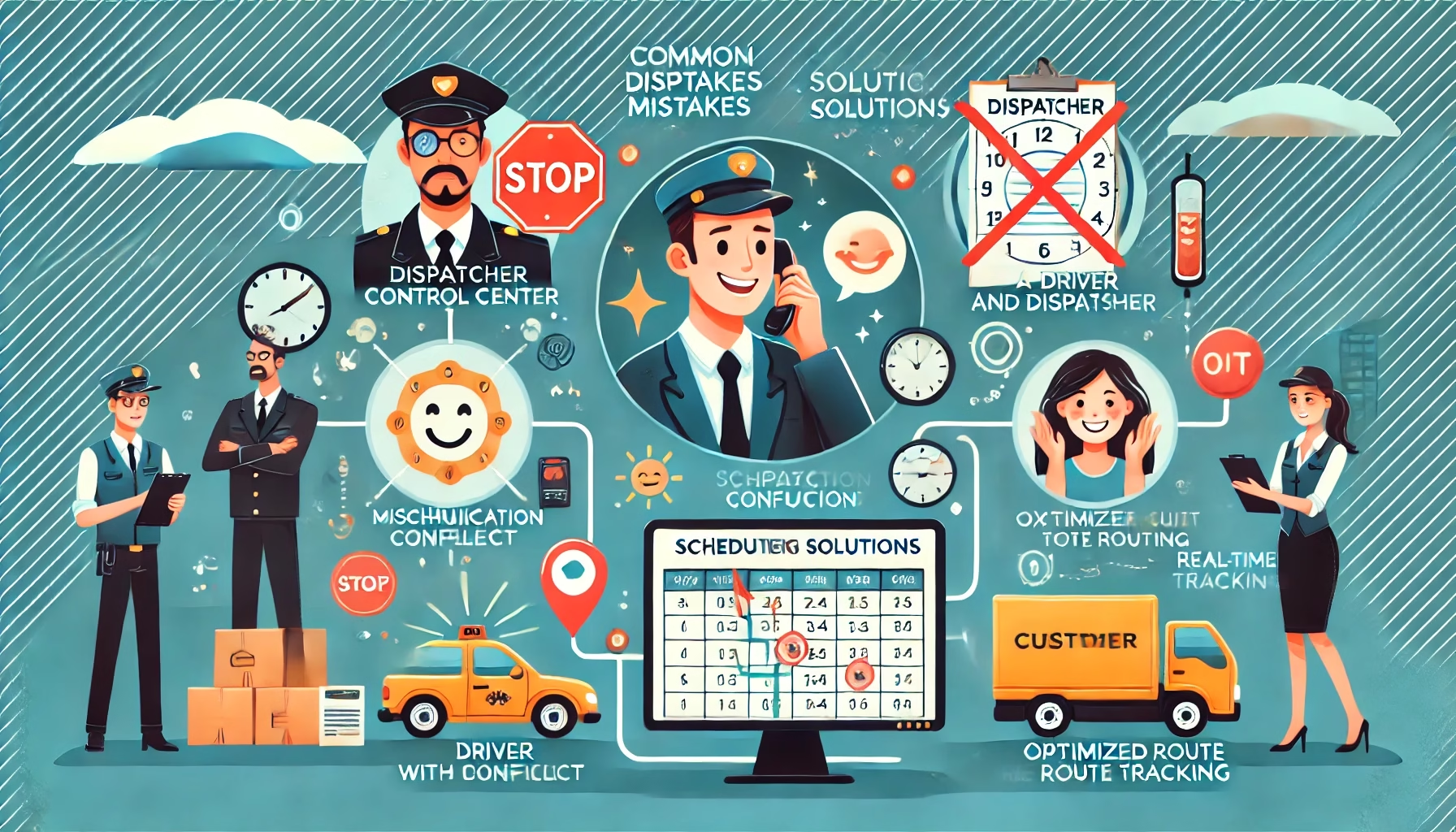Introduction
Dispatching plays a crucial role in transportation and fleet management. Whether you are managing a limousine service or a logistics company, efficient dispatching ensures timely operations, satisfied customers, and optimized resources. However, dispatching is prone to several common mistakes that can lead to delays, miscommunication, and operational inefficiencies.
To help businesses avoid dispatching common mistakes, this guide will cover the most frequent errors and provide practical solutions. By addressing these issues, companies can streamline their processes, improve customer service, and enhance overall efficiency.
1. Poor Communication Between Dispatchers and Drivers
The Issue
One of the most significant challenges in dispatching is the lack of clear communication between dispatchers and drivers. Misunderstandings, unclear instructions, or missing details can lead to delays, incorrect routes, and frustrated clients.
How to Avoid This Mistake
- Implement a Robust Communication System
Using reliable dispatch software with real-time tracking and messaging features is essential. Dispatchers should have direct and seamless communication channels with drivers, ensuring they receive clear and updated instructions. - Provide Comprehensive Training
Dispatchers and drivers should undergo regular training on using communication tools effectively. Clear protocols should be established to avoid misinterpretations. - Use Standardized Instructions
To avoid confusion, dispatchers should use a standardized format when providing trip details, ensuring that all necessary information is conveyed concisely.
2. Overbooking and Scheduling Conflicts
The Issue
Overbooking and scheduling conflicts can lead to missed appointments, frustrated clients, and operational inefficiencies. This mistake often occurs due to poor scheduling systems or last-minute changes.
How to Avoid This Mistake
- Leverage Advanced Scheduling Software
Modern dispatching software can automate scheduling, reducing human errors and ensuring no double bookings. - Implement Buffer Time Between Bookings
Allowing a buffer time between appointments ensures there is room for unforeseen delays, preventing overlaps. - Monitor and Adjust in Real-Time
A dedicated team should continuously monitor schedules and adjust assignments dynamically to avoid conflicts.
3. Inaccurate Driver and Vehicle Assignments
The Issue
Assigning the wrong driver or vehicle to a trip can cause significant operational challenges. The vehicle may not meet the client’s needs, or the driver may not be available.
How to Avoid This Mistake
- Use Intelligent Dispatching Systems
AI-powered software can match the right driver and vehicle to each trip based on real-time data and requirements. - Keep Updated Driver and Vehicle Records
Maintaining an up-to-date database of driver availability, certifications, and vehicle conditions ensures proper assignments. - Establish a Clear Allocation Process
A well-documented allocation strategy minimizes errors and ensures efficient trip management.
4. Failure to Optimize Routes
The Issue
Inefficient routing leads to delays, increased fuel costs, and unsatisfied customers. This often happens when dispatchers rely on outdated maps or fail to consider traffic conditions.
How to Avoid This Mistake
- Use GPS and Real-Time Traffic Monitoring
Integrating real-time traffic data into the dispatch system ensures optimal routing and reduces delays. - Plan and Adjust Routes Proactively
Routes should be reviewed and adjusted based on weather conditions, road closures, and customer locations. - Encourage Driver Feedback
Drivers on the road have firsthand experience of traffic conditions. Encouraging their input can lead to better routing decisions.
5. Ignoring Customer Preferences and Requests
The Issue
Ignoring specific customer requests, such as vehicle preferences or special instructions, can negatively impact customer satisfaction and loyalty.
How to Avoid This Mistake
- Maintain a Detailed Customer Database
Dispatch systems should store customer preferences to ensure a personalized experience. - Confirm Requests Before Dispatching
Double-checking special requests before confirming a trip avoids miscommunication. - Train Staff in Customer Service Excellence
Dispatchers should be trained to handle customer requests efficiently and courteously.
6. Lack of Proper Documentation
The Issue
Failure to keep accurate records of trips, driver logs, and vehicle maintenance can lead to compliance issues and operational inefficiencies.
How to Avoid This Mistake
- Use Automated Record-Keeping Software
Digital records reduce errors and make it easy to access historical data. - Implement Regular Audits
Regularly reviewing dispatch records ensures compliance and accuracy. - Standardize Documentation Processes
Establishing clear documentation protocols ensures all necessary details are recorded consistently.
7. Not Preparing for Emergencies
The Issue
Lack of contingency plans can result in operational breakdowns during unexpected situations like vehicle breakdowns or driver absences.
How to Avoid This Mistake
- Develop a Crisis Management Plan
Having predefined protocols ensures quick responses to emergencies. - Maintain Backup Drivers and Vehicles
A reserve fleet and on-call drivers can prevent service disruptions. - Use Dispatch Software with Emergency Alerts
Modern systems can notify dispatchers instantly in case of issues, enabling swift action.
8. Overlooking Driver Fatigue and Compliance
The Issue
Dispatchers often assign excessive trips to drivers, leading to fatigue and potential safety risks.
How to Avoid This Mistake
- Monitor Driver Hours
Ensuring drivers adhere to legal working hours prevents exhaustion. - Implement a Fair Dispatching System
Rotating driver assignments fairly prevents burnout and improves job satisfaction. - Encourage Breaks and Rest Periods
Proper rest periods ensure drivers remain alert and safe on the road.
9. Ignoring Customer Feedback
The Issue
Failing to address customer complaints can damage a company’s reputation.
How to Avoid This Mistake
- Implement a Feedback Collection System
Regularly collecting and analyzing feedback helps improve service quality. - Act on Complaints Promptly
Resolving issues quickly shows customers that their concerns matter. - Train Staff to Handle Feedback Professionally
Dispatchers and drivers should be equipped with skills to manage customer interactions effectively.
10. Relying on Outdated Technology
The Issue
Using outdated dispatch systems slows down operations and increases error rates.
How to Avoid This Mistake
- Invest in Modern Dispatch Software
Upgrading to the latest dispatch technology improves efficiency. - Regularly Update Systems
Keeping software and hardware updated prevents compatibility issues. - Train Staff on New Technology
Ensuring employees understand new tools maximizes their benefits.
Conclusion
Avoiding dispatching common mistakes is crucial for ensuring smooth operations, customer satisfaction, and business success. Implementing best practices in communication, scheduling, routing, and compliance will enhance efficiency and reduce costly errors.
To further optimize your dispatching process, consider using Saztech Solutions’ dispatch and customer support services. Their cutting-edge technology and expert support can help streamline operations and enhance customer satisfaction. Learn more at Saztech Solutions.
Home | About Us | Pricing | Get Started | FAQ | Dispatch Daily | Contact Us
WhatsApp | Facebook | LinkedIn





Leave a Reply